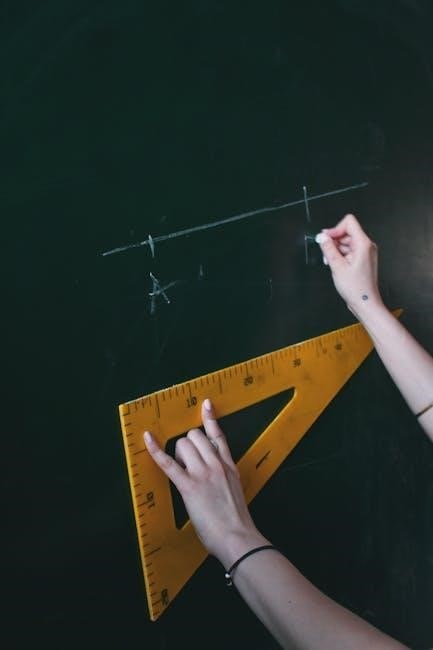Geometry explores the properties and relationships of points‚ lines‚ and shapes. It is fundamental for problem-solving in various fields‚ including architecture‚ engineering‚ and physics. Mastering basic concepts like angles‚ planes‚ and spatial reasoning builds a strong foundation for advanced mathematical studies.
1.1 Understanding the Fundamentals of Geometry
Geometry begins with understanding basic elements: points‚ lines‚ and planes. A point represents a location in space‚ while a line extends infinitely in two directions. Planes are flat surfaces that extend endlessly. These fundamentals help define angles‚ shapes‚ and their properties. Grasping these concepts is essential for analyzing spatial relationships and solving problems. Regular practice enhances spatial reasoning and visualization skills‚ which are critical for mastering geometry.
1.2 Key Concepts and Vocabulary
Mastering geometry requires understanding essential terms and concepts. Points‚ lines‚ and planes form the foundation. Angles‚ measured in degrees‚ are crucial for understanding shapes. Terms like “perpendicular” and “parallel” describe spatial relationships. Vocabulary such as “vertex‚” “edge‚” and “surface” aid in describing geometric figures. Familiarity with these concepts and terms is vital for solving problems and progressing in geometric studies. Regular review ensures a strong grasp of fundamental principles.

Points‚ Lines‚ and Planes
Points‚ lines‚ and planes are the building blocks of geometry‚ defining space and forming shapes. Understanding their properties is crucial for advanced geometric principles and problem-solving.
2.1 Definition and Properties
A point is a location in space‚ represented by coordinates. A line extends infinitely in both directions‚ defined by two points. A plane is a flat‚ two-dimensional surface extending infinitely. These elements form the basis of geometric concepts‚ with properties such as a line being one-dimensional and a plane containing an infinite number of lines.
2.2 Types of Lines and Planes
Lines can be classified as parallel‚ perpendicular‚ or skew. Parallel lines never intersect‚ while perpendicular lines form a 90-degree angle. Skew lines are non-parallel and do not intersect‚ existing in different planes. Planes can be intersecting or parallel. Intersecting planes meet along a line‚ while parallel planes never meet. Understanding these types is crucial for analyzing spatial relationships in geometry.

Angles and Their Measurements
Angles are formed by two rays sharing a common endpoint. They can be acute (less than 90°)‚ right (90°)‚ obtuse (more than 90°)‚ or straight (180°). Measuring angles accurately is essential for geometric calculations‚ often using tools like protractors to determine precise degree values.
3.1 Types of Angles
Angles are classified based on their degree measurements. Acute angles are less than 90 degrees‚ while right angles are exactly 90 degrees. Obtuse angles measure more than 90 but less than 180 degrees. Straight angles are 180 degrees‚ and reflex angles exceed 180 degrees. Understanding these classifications helps in solving geometric problems and visualizing spatial relationships effectively in various mathematical and real-world applications.
3.2 Measuring Angles with a Protractor
To measure angles accurately‚ align the protractor’s base with one side of the angle and ensure the vertex matches the center. Use the outer or inner scale‚ depending on the angle’s orientation. Read the degree where the other side intersects the scale. Always double-check alignment to avoid errors. This skill is essential for solving geometric problems and understanding spatial relationships in various applications.

Properties of Lines and Planes
Lines and planes have distinct properties‚ including being parallel‚ perpendicular‚ or intersecting. Understanding these relationships is crucial for solving geometric problems and visualizing spatial concepts effectively.
4.1 Parallel and Perpendicular Lines
Parallel lines never intersect and maintain a constant distance apart‚ while perpendicular lines intersect at a 90-degree angle. Recognizing these relationships is essential for solving geometric problems‚ as they form the basis for understanding angles‚ planes‚ and spatial structures. Mastery of parallel and perpendicular lines enhances problem-solving skills in geometry and related fields‚ providing a solid foundation for advanced mathematical concepts and practical applications in real-world scenarios. These properties are fundamental to constructing accurate diagrams and analyzing spatial relationships effectively. Understanding them is crucial for progressing in geometry and applying mathematical principles to various disciplines. By grasping these concepts‚ students can better comprehend more complex geometric theories and their practical uses. Geometry relies heavily on these basic principles‚ making them indispensable for any student aiming to excel in mathematics. These lines are the building blocks of geometric analysis‚ enabling the creation of precise models and accurate calculations. Their properties are essential for solving problems involving angles‚ distances‚ and shapes. Without a clear understanding of parallel and perpendicular lines‚ advancing in geometry becomes challenging‚ as these concepts are integral to higher-level topics. Therefore‚ dedicating time to mastering these principles is vital for success in geometry and its applications. This foundation supports more advanced studies‚ ensuring a comprehensive understanding of geometric relationships and their practical implications. By thoroughly learning these concepts‚ students can approach complex problems with confidence and accuracy‚ unlocking the full potential of geometric analysis. This knowledge is not only essential for academic success but also for real-world applications in fields like engineering‚ architecture‚ and design. Parallel and perpendicular lines are the cornerstone of geometric reasoning‚ providing the tools necessary to tackle a wide range of mathematical challenges. Their properties are consistently used in various mathematical proofs and constructions‚ reinforcing their importance in the study of geometry. As such‚ they remain a critical focus in the education and application of geometric principles. Understanding and applying these concepts correctly is key to mastering geometry and its numerous applications. This foundational knowledge empowers students to explore and solve complex problems with precision and clarity. By internalizing these principles‚ learners can approach geometric challenges with confidence‚ knowing they have a solid grasp of the underlying concepts. This‚ in turn‚ fosters a deeper appreciation for the structure and logic inherent in mathematics. The study of parallel and perpendicular lines is thus not only an academic exercise but also a gateway to understanding the broader applications of geometry in the world. These lines are fundamental to creating accurate representations of space and form‚ which are essential in various scientific and engineering disciplines. Their properties are consistently relied upon to develop solutions to real-world problems‚ highlighting the practical significance of these geometric concepts. In summary‚ parallel and perpendicular lines are indispensable in geometry‚ serving as the foundation for more complex analyses and applications. Their study is essential for any student seeking to master geometric principles and apply them effectively in diverse contexts. Through careful study and practice‚ students can gain a profound understanding of these concepts‚ enabling them to excel in their mathematical pursuits and beyond. The importance of these lines cannot be overstated‚ as they form the very fabric of geometric reasoning and problem-solving. By mastering parallel and perpendicular lines‚ students lay the groundwork for a successful and fruitful journey through the world of geometry. These concepts are not only tools for academic success but also keys to unlocking the logical and spatial reasoning skills that are invaluable in numerous professions. The thorough comprehension of parallel and perpendicular lines is‚ therefore‚ a cornerstone of a strong mathematical education. It equips students with the necessary skills to analyze and solve problems effectively‚ both within the classroom and in real-world scenarios. The continuous application of these principles ensures that students develop a robust understanding of geometric relationships‚ which is essential for tackling more advanced topics. In essence‚ the study of parallel and perpendicular lines is a critical component of geometry education‚ providing students with the foundational knowledge needed to excel in mathematics and its practical applications. By dedicating time to understand and apply these concepts‚ students can build a solid mathematical foundation that will serve them well in their future endeavors. The properties of parallel and perpendicular lines are timeless and universal‚ making them a constant and reliable tool in the realm of geometry. Their study is a testament to the enduring principles that govern the mathematical world‚ offering insights into the structure and order that underpin our universe. Through the exploration of these concepts‚ students gain not only academic knowledge but also a deeper appreciation for the beauty and logic of mathematics. The significance of parallel and perpendicular lines extends beyond the classroom‚ influencing various aspects of science‚ technology‚ engineering‚ and design. Their applications are vast and varied‚ underscoring the importance of a thorough understanding of these geometric principles. In conclusion‚ the study of parallel and perpendicular lines is a fundamental and essential part of geometry education. It provides students with the necessary tools to analyze spatial relationships‚ solve complex problems‚ and apply mathematical principles in real-world contexts. By mastering these concepts‚ students can confidently navigate the challenges of geometry and contribute meaningfully to fields that rely on mathematical precision and logical reasoning. The impact of understanding parallel and perpendicular lines is profound‚ shaping not only academic success but also the ability to engage with and solve practical problems in an increasingly complex world. These concepts are the bedrock upon which the edifice of geometry is built‚ ensuring that students have a stable and enduring foundation for their mathematical journey. The continuous study and application of parallel and perpendicular lines guarantee that students will be well-prepared to face the demands of higher-level mathematics and its applications. In the grand tapestry of mathematics‚ these lines are an essential thread‚ weaving together the fabric of geometric reasoning and problem-solving. Their study is a journey into the heart of mathematics‚ revealing the elegance and precision that define this discipline. By embracing the study of parallel and perpendicular lines‚ students embark on a path of discovery that enriches their understanding of the world and equips them with the skills to shape it. The legacy of these concepts lives on through their applications‚ inspiring future generations to explore and innovate within the realm of geometry. In the end‚ the mastery of parallel and perpendicular lines is not merely an academic achievement but a key to unlocking the doors of opportunity in mathematics and beyond.
4.2 Intersecting and Skew Lines
Intersecting lines cross at a single point‚ forming angles‚ while skew lines are non-parallel and do not intersect‚ existing in different planes. Understanding their properties is crucial for analyzing spatial relationships and solving geometric problems. These concepts are fundamental in three-dimensional geometry‚ helping to describe and visualize complex shapes and structures. Mastering intersecting and skew lines enhances spatial reasoning and problem-solving skills‚ essential for advanced geometry and real-world applications. Their study provides insights into the diversity of line interactions in space‚ aiding in the construction of accurate geometric models and diagrams. By understanding these concepts‚ students can better analyze and describe the relationships between lines in various dimensions‚ preparing them for more complex geometric challenges. These ideas are vital for grasping three-dimensional geometry and its practical uses in fields like engineering and architecture. The distinction between intersecting and skew lines highlights the importance of spatial awareness in geometric analysis‚ enabling precise calculations and accurate visualizations. This knowledge is indispensable for solving problems involving multiple planes and line interactions‚ fostering a deeper understanding of geometric principles. The study of intersecting and skew lines is thus a cornerstone of advanced geometric education‚ equipping students with the tools to tackle complex spatial problems with confidence and accuracy. By exploring these concepts‚ learners gain a robust foundation for analyzing and describing the intricate relationships between lines in three-dimensional space‚ a skill essential for success in mathematics and its applications. The understanding of intersecting and skew lines is a critical step in mastering the nuances of geometry‚ enabling students to approach problems with a comprehensive and insightful perspective. This knowledge not only enhances academic performance but also cultivates the spatial reasoning skills necessary for excelling in various scientific and engineering disciplines. The exploration of these concepts is a testament to the richness and complexity of geometric principles‚ offering students a profound appreciation for the structure of space and form. By dedicating time to study intersecting and skew lines‚ students can unlock the full potential of geometric analysis‚ preparing themselves for the challenges and opportunities that lie ahead in their mathematical journey. The significance of these concepts extends beyond the classroom‚ influencing fields that rely on precise spatial understanding and problem-solving abilities. The ability to distinguish and analyze intersecting and skew lines is a valuable skill that empowers students to engage with and solve complex problems in an increasingly three-dimensional world. These concepts are the building blocks of advanced geometric reasoning‚ providing students with the tools to explore and understand the intricacies of spatial relationships. By mastering intersecting and skew lines‚ students can approach geometric challenges with confidence‚ knowing they possess a solid foundation in three-dimensional analysis. This understanding is not only essential for academic success but also for contributing meaningfully to fields that depend on mathematical precision and spatial awareness. The study of intersecting and skew lines is thus a vital component of geometry education‚ offering insights into the structure of space and fostering the skills necessary to excel in a wide range of disciplines. By embracing these concepts‚ students can gain a deeper appreciation for the logic and beauty of mathematics‚ while also preparing themselves for the demands of an ever-evolving world. The exploration of intersecting and skew lines is a journey into the heart of geometric reasoning‚ revealing the elegance and complexity that define this field of study. Through careful study and practice‚ students can develop a profound understanding of these concepts‚ enabling them to navigate the challenges of three-dimensional geometry with ease and accuracy. The legacy of these principles lives on through their applications‚ inspiring future generations to explore and innovate within the realm of mathematics. In the end‚ the mastery of intersecting and skew lines is not merely an academic achievement but a key to unlocking the doors of opportunity in geometry and beyond.

Overview of Geometry
Geometry is the study of shapes‚ sizes‚ and positions‚ essential for problem-solving in fields like architecture and engineering. It provides foundational knowledge for spatial reasoning and practical applications in real-world scenarios‚ making it a cornerstone of mathematical education and innovation.
5.1 Importance of Geometry in Real Life
Geometry plays a vital role in various real-life applications‚ from architecture to engineering. It helps in designing structures‚ calculating distances‚ and understanding spatial relationships. In construction‚ geometric principles ensure stability and precision; Artists use geometry for proportions and perspectives‚ while scientists rely on it for mapping and analyzing data. Navigation systems‚ sports strategies‚ and even everyday problem-solving benefit from geometric concepts‚ making it an indispensable tool in modern life.
5.2 Branches of Geometry
Geometry is divided into several branches‚ each focusing on different aspects of spatial relationships. Euclidean geometry studies flat shapes like triangles and circles; Non-Euclidean geometry includes hyperbolic and elliptical geometries‚ exploring curved surfaces. Analytic geometry uses coordinates and algebra‚ while Riemannian geometry examines curved spaces. These branches collectively provide a comprehensive understanding of spatial properties‚ enabling advancements in fields like physics‚ engineering‚ and computer graphics.